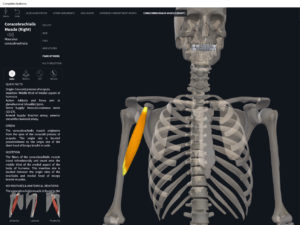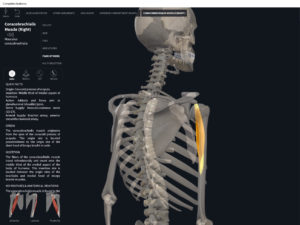Anatomy & Physiology: Muscles—Coracobrachialis.
Structure.
- Origin: coracoid process of scapula.
- Insertion: middle of medial surface of shaft of humerus.
Function.
- Concentric action: shoulder flexion and adduction. Horizontal arm flexion.
- Reverse mover action: upward tilt of the scapula at the glenohumeral (GH) and scapulocostal (ScC) joints. Downward scapular rotation. Scapular protraction.
- Eccentric action: controls/restrains/slows arm extension, abduction, and horizontal extension. Controls/restrains/slows scapular upward rotation, retraction, and downward tilt.
- Isometric action: stabilization of the shoulder girdle and scapula.
- Innervation: musculocutaneous nerve, C5, C6, C7.
- Arterial supply: muscular branches of brachial artery; anterior circumflex humeral artery.
Clinical Significance.
More.
- https://www.anatomynext.com/coracobrachialis/
- https://www.youtube.com/watch?v=aIMxxoqaJGw
- https://www.youtube.com/watch?v=NOBEq8Tu2hE
- https://www.youtube.com/watch?v=EMX12uGNtV8
References
Biel, A. (2015). Trail guide to the body: A hands-on guide to locating muscles, bones and more.
Cedars-Sinai. (2018). Vertebrae of the spine. Retrieved from https://www.cedars-sinai.org/health-library/diseases-and-conditions/v/vertebrae-of-the-spine.html
Clark, M., Lucett, S., Sutton, B. G., & National Academy of Sports Medicine. (2014). NASM essentials of corrective exercise training. Burlington, MA: Jones & Bartlett Learning.
Jenkins, G., & Tortora, G. J. (2012). Anatomy and Physiology: From Science to Life, 3rd Edition International Stu. John Wiley & Sons.
Muscolino, J. E. (2017). The muscular system manual: The skeletal muscles of the human body.



